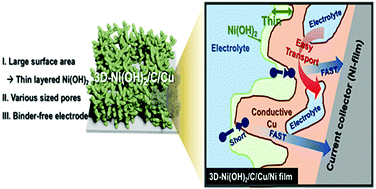Ultrathin nickel hydroxide on carbon coated 3D-porous copper structures for high performance supercapacitors†
Abstract
An ultrathin nickel hydroxide layer electrodeposited on a carbon-coated three-dimensional porous copper structure (3D-C/Cu) is suggested as an additive and binder-free conductive electrode with short electron path distances, large electrochemical active sites, and improved structural stability, for high performance supercapacitors. The 3D-porous copper structure (3D-Cu) provides high electrical conductivity and facilitates electron transport between the Ni(OH)2 active materials and the current collector of the Ni-plate. A carbon coating was applied to the 3D-Cu to prevent the oxidation of Cu, without degrading the electron transport behavior of the 3D-Cu. The 3D-Ni(OH)2/C/Cu exhibited a high specific capacitance of 1860 F g−1 at 1 A g−1, and good cycling performance, with an 86.5% capacitance retention after 10 000 cycles. When tested in a two-electrode system, an asymmetric supercapacitor exhibited an energy density of 147.9 W h kg−1 and a power density of 37.0 kW kg−1. These results open a new area of ultrahigh-performance supercapacitors, supported by 3D-Cu electrodes.



 Please wait while we load your content...
Please wait while we load your content...